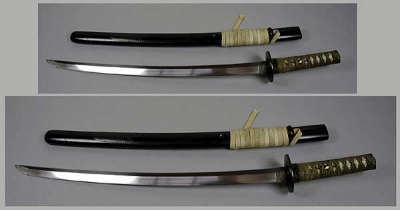Daisho (1929.17.3)
 JapanDaisho from Japan, Asia. Collected by Robert Walter Campbell Shelford. Given to the Museum by Mrs. Shelford in 1929.
JapanDaisho from Japan, Asia. Collected by Robert Walter Campbell Shelford. Given to the Museum by Mrs. Shelford in 1929.
A samurai always wore his bladed weapons in pairs. The traditional military custom was to wear a longsword, known as a tachi, with a tanto, a small, armour-piercing dagger. However, from the 16th century, as infantry tactics took over from mounted combat and the samurai became engaged in administrative and parade duties more than warfare, the fashion changed to favour the daisho.
The daisho comprised the long katana and the shorter wakizashi and the two swords were nearly always mounted in an identical manner. These examples have black lacquered scabbards with grey crayfish decoration. The blades were made in the early 17th century by the Echizen smith, Kanenori, the metal fittings are at least 100 years younger and are of shibuichi, a copper-silver alloy virtually exclusive to Japan that can produce unusual patinas of green, brown and grey.
Warrior Elites
This is an example of the civilian form of daisho, which was worn in peacetime with normal dress. The katana was carried blade upwards through the sash-belt, on the left hip. The shorter wakizashi was carried through the same belt, blade upwards, across the belly, with the hilt to the right. In the military form of daisho, swords were worn with armour and secured to the body with sword-belts and metal fittings on the blade and scabbard.
Only the samurai class were allowed to wear the daisho. However, prior to 1588, they had no exclusive access to warriorship. In that year, the powerful samurai general Toyotoma Hideyoshi passed the Sword Collection Edict, making it illegal for members of the agricultural and artisan classes to possess weapons. The samurai rigidly maintained their exclusive privilege to bear arms thereafter, and the daisho became the primary insignia of the samurai warrior for almost 300 years.
The wearing of daisho was highly formalised. Samurai learned to walk, stand and sit with daisho in a non-threatening manner, and remain constantly aware of the location of their swords. To clatter a sword when passing another armed man was paramount to drawing it or a verbal insult, and often resulted in bloodshed. When a samurai paid a house call, he was expected to hand over his blades at the door, which were stored in clear view until he left. If he was permitted to keep his daisho, the side at which he placed them beside himself when he sat, and the direction their blades faced, was viewed as a silent signal of his intent, and responded to accordingly. It was through this life-and-death necessity of correct sword-protocol that Iaido developed - a formalised art of donning, wearing, removing, drawing and using swords, which is still practised in martial arts today.
The Boshin War of 1867-9 resulted in the Meiji Restoration of the Emperor's direct rule, after centuries of rule by the Tokugawa Shogunate - a powerful samurai dynasty. The Emperor abolished the samurai class entirely and made it illegal to wear or own daisho. Japan underwent rapid military Westernisation during the last third of the 19th century and the nation's army was transformed, modelled on the most modern German armies of the time.





